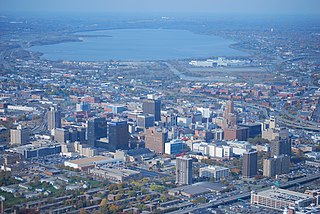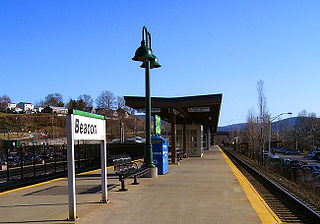
The Beacon station is a commuter rail stop on the Metro-North Railroad's Hudson Line, serving Beacon, New York. Trains leave for New York City every hour during off peak hours, and about every 15–25 minutes during rush hour. It is 59 miles (95 km) from Grand Central Terminal, the travel time from which varies depending on run, ranging from 1 hour and 10 minutes to 1 hour and 15–18 minutes (trains making all local stops north of Croton-Harmon and 1 hour and 25–30 minutes. This station is heavily used by residents of Orange and Rockland Counties who drive to the station.
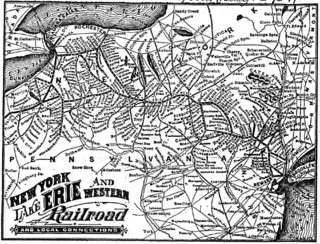
The Erie Railroad was a railroad that operated in the northeastern United States, originally connecting New York City — more specifically Jersey City, New Jersey, where Erie's former terminal, long demolished, used to stand — with Lake Erie. It expanded west to Chicago with its 1941 merger with the former Atlantic and Great Western Railroad, also known as the New York, Pennsylvania and Ohio Railroad. Its mainline route proved influential in the development and economic growth of the Southern Tier, including cities such as Binghamton, Elmira, and Hornell. The Erie Railroad repair shops were located in Hornell, and were Hornell's largest employer. Hornell was also where Erie's main line split into two routes, one north to Buffalo and the other west to Cleveland.
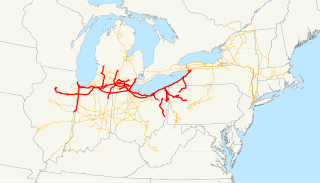
The Lake Shore and Michigan Southern Railway, established in 1833 and sometimes referred to as the Lake Shore, was a major part of the New York Central Railroad's Water Level Route from Buffalo, New York, to Chicago, Illinois, primarily along the south shore of Lake Erie and across northern Indiana. The line's trackage is still used as a major rail transportation corridor and hosts Amtrak passenger trains, with the ownership in 1998 split at Cleveland between CSX to the east, and Norfolk Southern in the west.

The Central New England Railway was a railroad from Hartford, Connecticut and Springfield, Massachusetts west across northern Connecticut and across the Hudson River on the Poughkeepsie Bridge to Maybrook, New York. It was part of the Poughkeepsie Bridge Route, an alliance between railroads for a passenger route from Washington to Boston, and was acquired by the New York, New Haven & Hartford Railroad in 1904.

The Boston and Albany Railroad was a railroad connecting Boston, Massachusetts to Albany, New York, later becoming part of the New York Central Railroad system, Conrail, and CSX Transportation. The line is currently used by CSX for freight. Passenger service is still operated on the line by Amtrak, and by the MBTA Commuter Rail system, which owns and uses the section east of Worcester as their Framingham/Worcester Line.

The Central Massachusetts Railroad was a railroad in Massachusetts. The eastern terminus of the line was at North Cambridge Junction where it split off from the Middlesex Central Branch of the Boston and Lowell Railroad in North Cambridge and through which it had access to North Station in Boston. From there, the route ran 98.77 miles west through the modern-day towns of Belmont, Waltham, Weston, Wayland, Sudbury, Hudson, Bolton, Berlin, Clinton, West Boylston, Holden, Rutland, Oakham, Barre, New Braintree, Hardwick, Ware, Palmer, Belchertown, Amherst, and Hadley to its western terminal junction at N. O. Tower in Northampton with the Connecticut River Railroad.

The Newburgh, Dutchess and Connecticut Railroad, originally the Dutchess and Columbia Railroad and affectionately "The Never Did and Couldn't", is a link in the New York, New Haven and Hartford Railroad system in New York state.

The West Shore Railroad was the final name of a railroad that ran from Weehawken, New Jersey, which is across the Hudson River from New York City, north along the west shore of the river to Albany, New York and then west to Buffalo. It was organized as a competitor to the New York Central and Hudson River Railroad, but was soon taken over by that company.
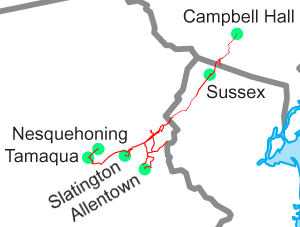
The Lehigh & New England Railroad was a Class I railroad located in Northeastern United States that acted as a bridge line. It was the second notable U.S. railroad to file for abandonment in its entirety, the first being the New York, Ontario & Western Railway.
The Housatonic Railroad is a Class III railroad operating in southwestern New England. It was chartered in 1983 to operate a short section of ex-New York, New Haven and Hartford Railroad in northwestern Connecticut, and has since expanded north and south, as well as west into New York State.

The Uptown Hudson Tubes are a pair of tunnels that carry PATH trains between Manhattan, New York City, to the east and Jersey City, New Jersey, to the west. The tubes originate at a junction of two PATH lines on the New Jersey shore and cross eastward under the Hudson River. On the Manhattan side, the tubes run mostly underneath Christopher Street and Sixth Avenue, making four intermediate stops before terminating at 33rd Street station. Despite their name, the tubes do not enter Uptown Manhattan, but are so named because they are located to the north of the Downtown Hudson Tubes, which connect Jersey City and the World Trade Center.
The Jersey Shore, Pine Creek and Buffalo Railway was a railroad built in the early 1880s to give the New York Central and Hudson River Railroad access to the coal regions around Clearfield, Pennsylvania, United States. It was originally planned as part of a connecting line between the East Coast of the United States and Buffalo, New York.

The Newark and New York Railroad was a passenger rail line that ran between Downtown Newark and the Communipaw Terminal at the mouth of the North River in Jersey City, bridging the Hackensack River and Passaic River just north of their mouths at the Newark Bay in northeastern New Jersey. The Central Railroad of New Jersey operated it from its opening in 1869. Through operation ended in 1946; portions remained in use until 1967.
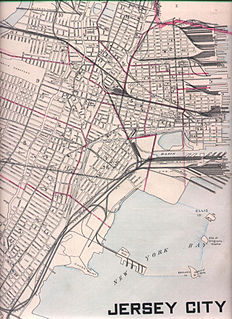
National Docks Secondary is freight rail line within Conrail's North Jersey Shared Assets Area in Hudson County, New Jersey, used by CSX Transportation. It provides access for the national rail network to maritime, industrial, and distribution facilities at Port Jersey, the Military Ocean Terminal at Bayonne (MOTBY), and Constable Hook as well as carfloat operations at Greenville Yard. The line is an important component in the planned expansion of facilities in the Port of New York and New Jersey. The single track right of way comprises rail beds, viaducts, bridges, and tunnels originally developed at the end of the 19th century by competing railroads.
The Railroad industry in Syracuse, New York got its start in October 1831 when a convention held in the city marked one of the earliest moves to stimulate the era of railroad building which ultimately brought steam railroad service to New York State.
The Syracuse Northern Railroad, incorporated in 1868 and opened on November 9, 1871, drew trade from Liverpool to Syracuse, New York. The line had routes to Watertown, New York, and in 1875, the road was extended to Pulaski and Lacona.
The Syracuse, Phoenix and Oswego Railroad was chartered on November 29, 1871, and had a route from Woodard, located north of Syracuse, New York, to Fulton, New York, a distance of 17.11 miles (27.54 km). They merged with the Syracuse Northwestern Railroad on June 10, 1875, and incorporated as Syracuse, Phoenix and Oswego Railway on February 16, 1885.
The Syracuse Northwestern Railroad was established in 1874 and ran from Woodard to Haymarket Square in Syracuse, New York. The road was consolidated under the Syracuse, Phoenix and Oswego Railroad in 1875 and was sold under a judgement in 1885 under the name Syracuse, Phoenix and Oswego Railway.

Interurban and streetcar railways flourished in Syracuse, New York until the automobile, airplane and bus took their place.
